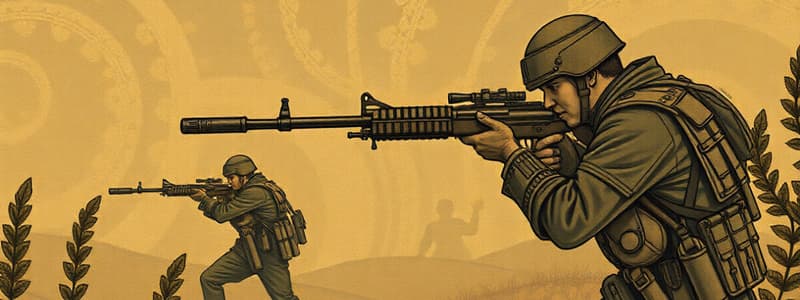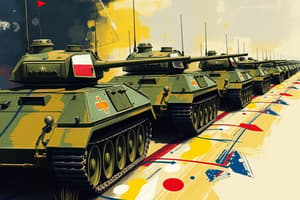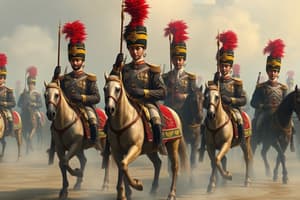Podcast
Questions and Answers
What is the primary definition of 'line of fire' in military operations?
What is the primary definition of 'line of fire' in military operations?
- The distance from the shooter to the target
- A direct line of sight between a sniper and their target (correct)
- Any defensive position taken by a soldier
- The direction of enemy attacks
Which factor does NOT affect the line of fire in military operations?
Which factor does NOT affect the line of fire in military operations?
- Target movement
- Terrain
- Weather conditions
- The color of the uniform worn by soldiers (correct)
How does target movement impact the line of fire?
How does target movement impact the line of fire?
- It guarantees a successful engagement
- It allows for easier targeting of stationary objects
- It eliminates the need for adjustments to the shooter's position
- It requires ongoing adjustments to the shooter's position and aim (correct)
In the context of military operations, why is assessing the line of fire critical?
In the context of military operations, why is assessing the line of fire critical?
Which of the following best illustrates the metaphorical extension of 'line of fire' in civilian contexts?
Which of the following best illustrates the metaphorical extension of 'line of fire' in civilian contexts?
What role does shooting position play in the line of fire?
What role does shooting position play in the line of fire?
Which is a common obstacle that can affect the line of fire?
Which is a common obstacle that can affect the line of fire?
What tools are vital for confirming the line of fire in real-world scenarios?
What tools are vital for confirming the line of fire in real-world scenarios?
Flashcards
Line of Fire
Line of Fire
A direct line of sight between a sniper and their target, crucial for accurate engagements in military operations.
Terrain Affecting Line of Fire
Terrain Affecting Line of Fire
Hills, valleys, buildings, or trees can block the line of fire, requiring adjustments for elevation and angle.
Weather Impact on Line of Fire
Weather Impact on Line of Fire
Weather conditions like fog, rain, or snow can hinder visibility and accuracy, impacting the line of fire.
Obstacles Blocking Line of Fire
Obstacles Blocking Line of Fire
Signup and view all the flashcards
Target Movement Affecting Line of Fire
Target Movement Affecting Line of Fire
Signup and view all the flashcards
Shooting Position Impact on Line of Fire
Shooting Position Impact on Line of Fire
Signup and view all the flashcards
Sighting and Aiming for Line of Fire
Sighting and Aiming for Line of Fire
Signup and view all the flashcards
Importance of Line of Fire in Military Operations
Importance of Line of Fire in Military Operations
Signup and view all the flashcards
Study Notes
Definition and Concept
- "Line of fire" refers to a direct line of sight between a sniper and their target.
- This is a critical concept in military operations and marksmanship, dictating the feasibility of accurate engagements.
- The line of fire is often considered the most direct path for projectile travel.
- Obstacles in the line of fire can significantly hinder or preclude successful engagement.
Factors Affecting Line of Fire
- Terrain: Hills, valleys, buildings, and trees can block the line of fire, reducing engagement options or requiring adjustments for elevation and angle.
- Weather conditions: Factors like fog, rain, or snow can impede visibility and compromise accuracy, affecting the line of fire.
- Obstacles: Anything, human or physical, that obstructs a clear line of sight alters or cancels the line of fire—the most obvious example is obscuring structures.
- Target Movement: The target's movement can alter the line of fire, requiring ongoing adjustments to the shooter's position and aim, making static targeting difficult.
- Shooting Position: The shooter's position impacts their view of the target and the line of fire, with elevated positions often offering a more expansive view. This also affects effective range.
- Sighting and Aiming: Accurate sighting and aiming equipment, and the practitioner's skill, are integral factors in determining the effectiveness of the assessment, and the success of the engagement aligned with the line of fire.
Importance in Military Operations
- Assessing the line of fire is crucial for tactical planning and execution.
- Understanding the line of fire maximizes the potential for successful engagements.
- Tactical analysis prioritizes identifying likely lines of fire to optimize fire support and minimize casualties.
Beyond Military Contexts
- The concept of a "line of fire" can be extended metaphorically to represent the path of conflict or attack in civilian contexts.
- Using the concept in a metaphorical context, it can apply to situations where there's a direct engagement or attack against a target and where success depends on maintaining a decisive path to the target. Even in non-hostile contexts, the path can be seen as the "line of fire."
Practical Application
- In real-world scenarios, a precise line of fire calculation is key for accurate targeting.
- Utilizing maps, terrain data, and aiming tools are vital for identifying and confirming the line of fire.
- Factors like wind, range, and atmospheric conditions need considering when evaluating engagement opportunities.
Tactical Considerations
- The concept is crucial for defining optimal firing positions and minimizing collateral damage.
- Avoiding friendly fire incidents is a critical consideration which requires understanding of the established lines of fire.
- Knowledge of enemy positions is paramount to understanding and mitigating the threats posed by various lines of fire.
Studying That Suits You
Use AI to generate personalized quizzes and flashcards to suit your learning preferences.





